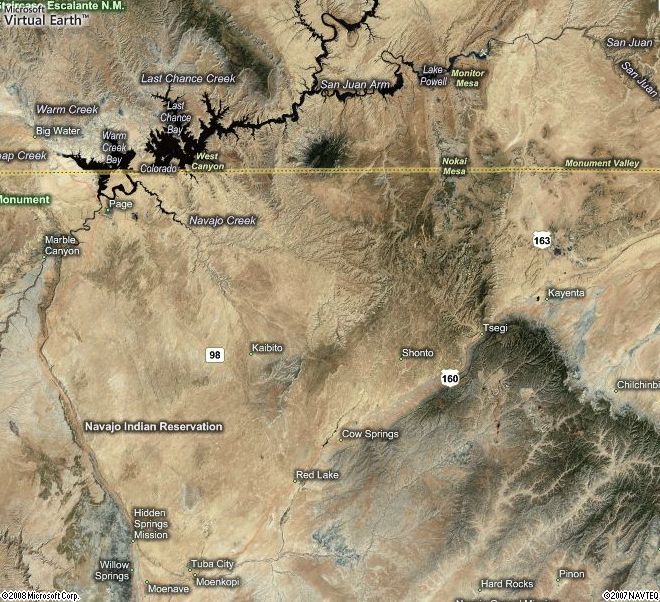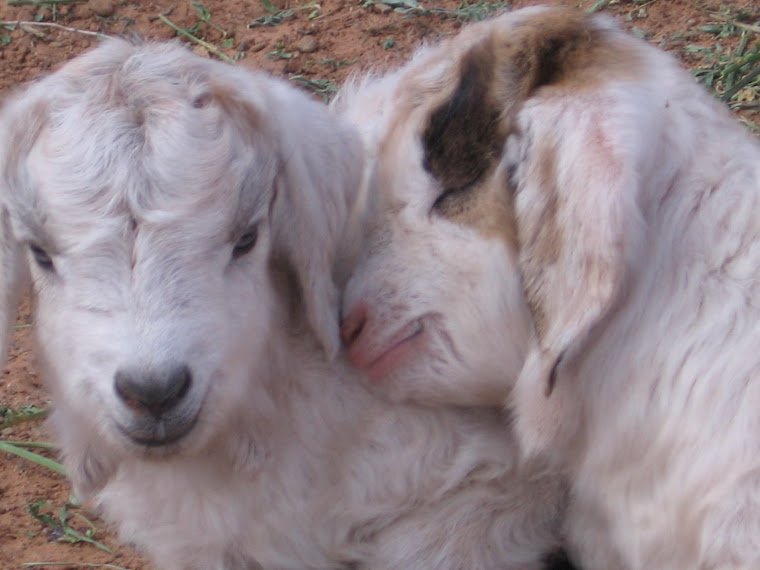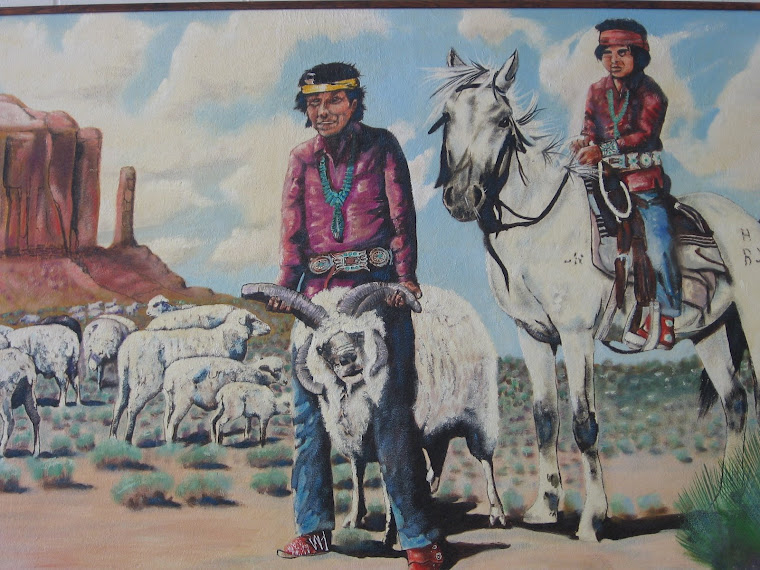Wednesday, October 15, 2008
Slick McCain's genocide plan for Navajos
Sen. John McCain supports ongoing genocide against the Navajo Nation
Submitted by dcu on Sat, 07/08/2006
My wife and I have just returned from visiting Navajo friends in New Mexico and Arizona. Upon returning home I received an email from a friend in Colorado about what John McCain is doing to the Navajo people. Read about it below the fold:
S. 1003 Passes Through the Senate
Sen. John McCain paints on a counterfeit grin as he waves to the crowds that have come to support him. If people knew the clandestine actions taking place behind his practiced pose, they would be throwing eggs at him instead of admiring glances..
McCain, chairman of the Senate Committee on Indian Affairs is campaigning to put an end to Navajo relocation costs via the S. 1003 bill. This would mean that the government is no longer accountable ethically or financially for the chaos it has inflicted on innocent Navajo people. S. 1003 has now passed the Senate. It is moving fast to the House for approval.
Traditionally nomadic in the Arizona area, the Navajo were coupled with their friends the Hopi and both were forced upon this reservation, located around Big Mt./Black Mesa in the NE corner of Arizona. In 1882 the powers that be at the time knew there were fossil fuels underground. They also calculated that the Native Americans were easier to manipulate then white settlers and thus placed the vulnerable Navajo and Hopi there, knowing that someday the fossil fuels would be harvested from the land. In the 1950’s the push came to get rid of just the Navajo.
The forced exodus of over 12,000 Navajo people ensued which shattered them physically, spiritually, mentally and emotionally. Death by grief is a grim reality in this community. Through this forced relocation the federal government has destroyed the subsistence lifestyle of thousands of Navajos, uprooted whole communities, and left the Navajo Nation and Navajo people to bear much of the burden of addressing the extraordinary economic, social and psychological consequences of relocation. Congress never understood the situation of the people living on the land, and refused to see the costs or the heartbreak.
Genocide is sometimes fought against by our government in other countries but is deliberate on this Navajo reservation. How dare we preach to other countries when we are doing this to our own people here at home! None of which would be tolerated in mainstream society. These crimes are perpetuated by the corporate media who refuses to highlight this story of Homeland Terrorism.
The Navajo “resistors” who refused to relocate have been harassed to leave by armed police through physical abuse and intimidation. Also being classified as trespassers on their own land, they are denied their basic=2 0human rights to practice their religious ceremonies, to fix or build homes through a law named the Bennett Freeze and forbidden to collect wood for their fires. In addition their sheep, cattle and horses are impounded to strip them of their sustenance.
The place that the Dine’ people are relocated to was named the “New Lands.” The name conjures up a rosy image. But in reality the New Lands are lethal to inhabitants because it is downstream from the largest uranium spill in US history. There are former EPA officials who are willing to testify that the New Lands should be made a superfund site and all inhabitants removed. The displaced Navajo just want to go home and live traditionally in peace.
In blind pursuit of the coal, ancient ceremonial sites, petroglyphs, artifacts and burial grounds have been destroyed along with people’s homes, air, land, medicinal plants and water supplies. The harvesting and usage of coal fired power plants is deadly to humans and the earth. As illustrated in Al Gore’s movie “An Inconvenient Truth” America is the biggest polluter globally and much of the pollution is caused by fossil fuel usage.
In sanctioning relocation, our government ignored more humane alternatives for resolving this conflict. A cash settlement to the people affected is the norm when land is taken. If McCain’s bill S. 1003 is made into law, the Navajo will be forcibly removed from the land without compensation and n o safe place to go. This is outrageous and in opposition to the United States Constitution. Our government is the bully in this arena and conceals its policy of thrashing its poorest but most sacred residents. Native people are a unique and treasured natural resource. Ancient wisdom and culture is endangered as the cadence of the government spin picks up it’s pace. It is time to unify to rectify these injustices. The time is now.
There are actions that all citizens can take to help the Navajo win this agonizing battle. Mobilize your circles to create a massive flood of faxes then phone calls to your local senators and representatives. In addition to your local congresswomen & men a deluge of communications is needed to be sent to Congressman Rick Renzi who represents the Big Mt./Black Mesa area. Contact Renzi by phone: 202-225-2315 or fax: 202-226-9739. DEMAND a one year study to examine and assess the impacts and effects relocation has had on Navajo people. This assessment will then serve as a policy and fact based tool for developing a humane closure plan. Also demand that the Navajo be allowed to return from the New Lands to their reservation in Big Mt./Black Mesa and to allow all Navajo there to live in peace and harmony.
See this website for more details:
www.blackmesais.org.
Each voice makes a difference-please act today
16.10.08
26.6.08
Protecting Mount Taylor

P.O. BOX 7440 WINDOW ROCK, AZ 86515 ! (928) 871-7000 ! FAX: (928) 871-4025
CONTACT: GEORGE HARDEEN
COMMUNICATIONS DIRECTOR
OFFICE – 928-871-7917
CELL – 928-309-8532
pressoffice@opvp.org
Navajo Nation Vice President Ben Shelly (second from right) joined tribal leaders joined to commend the New Mexico Cultural Properties Review Committee’s June 14 decision to place Mount Taylor on the Emergency Listing of the New Mexico Register of Cultural Properties. From left to right is Hopi Tribal Chairman Benjamin Nuvamsa, Laguna First Lt. Governor Richard Luarkie, Zuni Governor Norman Cooeyate,
and Acoma First Lt. Governor Mark Thompson.
Navajo Nation Vice President Ben Shelly joins tribal leaders
to commend cultural property protection for Mount Taylor
ACOMA, N.M. – Navajo Nation Vice
President Ben Shelly joined four other tribal
leaders during to commend the June 14
decision of the New Mexico Cultural
Properties Review Committee to place Mount
Taylor on the Emergency Listing of the New
Mexico Register of Cultural Properties.
“The Navajo people are tied to the land and
sky through prayers and songs that were
sung by the Holy People during the creation
of the mountains and the world,” the Vice
President said. “Our sacred mountains give
the Navajo people strength, and through the
role of Nahat’á – leadership and planning,”
said Vice President Shelly.
Joining the Vice President was Zuni Governor
Norman Cooeyate, Hopi Chairman Benjamin
Nuvamsa, Acoma First Lt. Governor Mark
Thompson, and Laguna First Lt. Governor
Richard Luarkie.
“Traditional Navajo people have always looked
to these mountains for guidance and leadership for the
Navajo people and the Navajo Nation Government,” Vice
President Shelly said. “Each mountain is honored and
respected by Navajo people daily through offering song
and prayer.”
The five nominating tribes, including the Pueblos of
Acoma, Zuni, and Laguna, the Hopi Tribe and the Navajo
Nation, pushed for the designation of areas above 8,000
feet on Mount Taylor and the top of Horace Mesa as a
traditional cultural property, or TCP, which is an area
deemed important to maintain the cultural identity of a
community.
“Sacred shrines, trails and offering places maintain great
cultural and religious significance,” Zuni Governor
Cooeyate said. “These properties are imbued with life
and spiritual forces that have been blessed by our creator
since time immemorial before their use, and once
blessed, they are blessed in perpetuity.”
The temporary one-year listing of Mount Taylor to the
New Mexico Register of Cultural Properties provides a
layer of protection by requiring adverse development
within the TCP area be reviewed by the New Mexico
Historic Preservation Office.
“Mount Taylor is known and remembered in our songs,
ceremonies, and shrines,” Hopi Chairman Nuvamsa said.
THE NAVAJO NATION
OFFICE OF THE PRESIDENT & VICE PRESIDENT
FOR IMMEDIATE RELEASE
JUNE 24, 2008
P.O. BOX 7440 WINDOW ROCK, AZ 86515 ! (928) 871-7000 ! FAX: (928) 871-4025
“The Hopi Tribe provided documentation to the committee
in our petition establishing cultural associations with
Mount Taylor, and demonstrating that 28 Hopi deities and
other religious personages, 36 Hopi clans, and a number
of Hopi religious societies have close cultural connections
with Mount Taylor.”
Within one year, the nominating tribes must prepare a
permanent designation application and must go before
the committee to seek a permanent designation.
“We believe in sustaining life on the mountain,” Laguna
First Lieutenant Governor Luarkie said. “This means
protecting the water resources. We have great concerns
that unimpeded development could affect the water
resources.”
He said the headwaters for several of Laguna
communities are located within the TCP area for which
the tribes seek designation. Without healthy water, many
forms of life will cease to live, he said.
Arvin Trujillo, executive director of the Navajo Nation
Division of Natural Resources, Alan Downer, director of
the Navajo Nation Historic Preservation Department, and
deputy director Steven Begay assisted with Navajo
Nation testimony.
The Historic Preservation Department will collaborate
with area tribes to responsibly and respectfully manage
our Navajo cultural resources, especially Mount Taylor,
Mr. Begay said.
# # #
4.6.08
The American Academy Helps Navajo Nation Preserve Language, History
http://www.centredaily.com/news/education/v-print/story/633066.html
Centre Daily Times Tue, 03 Jun 2008 8:06 AM PDT
Tuesday, Jun. 03, 2008
The American Academy Helps Navajo Nation Preserve Language, History
SALT LAKE CITY — Navajo students can now learn their tribe's customs and language while becoming eligible for scholarships, thanks to two Navajo courses now being offered by leading online high school The American Academy.
The American Academy offers courses in Navajo Government and Navajo Language. Both courses are intended to enrich the cultural knowledge of students within and outside of the Navajo Nation. The Navajo Government course covers the evolution of Navajo government from its beginnings to the present time. In the Navajo Language course students learn to speak, write, and read numerals, anatomy, conversational phrases and other common terms.
"It's very important to the Navajo people to pass their traditions and language down from generation to generation," said Rebekah Richards, senior vice president of academic affairs and principal of The American Academy. "Teachers who are qualified to educate students about Dine culture are rare, particularly outside the reservation. We help members of the Navajo Nation preserve their cultural heritage by offering these online courses -- students anywhere in the country can access the courses and master the content with the help of a Navajo teacher."
High school credit for both courses is required to be eligible for the Chief Manuelito Scholarship, a four-year, $7000 per year scholarship awarded annually by the Navajo Nation to high-achieving Navajo students entering their first year of college. Several American Academy students are currently eligible for the award; recipients of the scholarship will be announced in July. Previously students outside traditional Navajo regions had little or no access to cultural courses from accredited institutions, but having the courses available online expands the potential scholarship applicant pool significantly.
"We sought availability of online Navajo courses because many schools that serve Navajo children do not offer such courses at the high school," said Rose Graham, director of the Navajo Nation Office of Scholarship and Financial Assistance. "Also, there are Navajo families in just about every state of the union where Navajo Language and History are definitely not taught in schools."
The American Academy is accredited by the Northwest Association of Accredited Schools, which means that credits earned at The American Academy will transfer to public and accredited private high schools across the country. The American Academy serves students throughout the U.S. and in several countries. Every student has access to licensed instructors and to tutoring available on-demand, 24/7.
Enrollment is now open at The American Academy, and 233 different classes begin every Monday. For more information, please visit http://www.TheAmericanAcademy.com.
About The American Academy
The American Academy is an accredited online high school built on a system that has served more than 80,000 students since 1994. It serves students worldwide who want to supplement their high school program or earn their high school diploma. The American Academy offers a flexible educational experience along with a high quality, engaging curriculum that aligns with state standards. Through its relationships with long-standing education institutions, including the Utah State Board of Education, The American Academy provides leading-edge resources and access to licensed, experienced instructors. For more information, please visit http://www.TheAmericanAcademy.com
Sprout Marketing for The American Academy Alex Koritz, 801-641-3808 alex@sproutmarketing.com
Centre Daily Times Tue, 03 Jun 2008 8:06 AM PDT
Tuesday, Jun. 03, 2008
The American Academy Helps Navajo Nation Preserve Language, History
SALT LAKE CITY — Navajo students can now learn their tribe's customs and language while becoming eligible for scholarships, thanks to two Navajo courses now being offered by leading online high school The American Academy.
The American Academy offers courses in Navajo Government and Navajo Language. Both courses are intended to enrich the cultural knowledge of students within and outside of the Navajo Nation. The Navajo Government course covers the evolution of Navajo government from its beginnings to the present time. In the Navajo Language course students learn to speak, write, and read numerals, anatomy, conversational phrases and other common terms.
"It's very important to the Navajo people to pass their traditions and language down from generation to generation," said Rebekah Richards, senior vice president of academic affairs and principal of The American Academy. "Teachers who are qualified to educate students about Dine culture are rare, particularly outside the reservation. We help members of the Navajo Nation preserve their cultural heritage by offering these online courses -- students anywhere in the country can access the courses and master the content with the help of a Navajo teacher."
High school credit for both courses is required to be eligible for the Chief Manuelito Scholarship, a four-year, $7000 per year scholarship awarded annually by the Navajo Nation to high-achieving Navajo students entering their first year of college. Several American Academy students are currently eligible for the award; recipients of the scholarship will be announced in July. Previously students outside traditional Navajo regions had little or no access to cultural courses from accredited institutions, but having the courses available online expands the potential scholarship applicant pool significantly.
"We sought availability of online Navajo courses because many schools that serve Navajo children do not offer such courses at the high school," said Rose Graham, director of the Navajo Nation Office of Scholarship and Financial Assistance. "Also, there are Navajo families in just about every state of the union where Navajo Language and History are definitely not taught in schools."
The American Academy is accredited by the Northwest Association of Accredited Schools, which means that credits earned at The American Academy will transfer to public and accredited private high schools across the country. The American Academy serves students throughout the U.S. and in several countries. Every student has access to licensed instructors and to tutoring available on-demand, 24/7.
Enrollment is now open at The American Academy, and 233 different classes begin every Monday. For more information, please visit http://www.TheAmericanAcademy.com.
About The American Academy
The American Academy is an accredited online high school built on a system that has served more than 80,000 students since 1994. It serves students worldwide who want to supplement their high school program or earn their high school diploma. The American Academy offers a flexible educational experience along with a high quality, engaging curriculum that aligns with state standards. Through its relationships with long-standing education institutions, including the Utah State Board of Education, The American Academy provides leading-edge resources and access to licensed, experienced instructors. For more information, please visit http://www.TheAmericanAcademy.com
Sprout Marketing for The American Academy Alex Koritz, 801-641-3808 alex@sproutmarketing.com
15.5.08
Navajo Council Delegate Maxx testifies in Washington
May 15, 2008
Navajo Council Delegate Maxx testifies in Washington
Senate hearing on S.B. 531 prevents reinstatement of Bennett Freeze
WINDOW ROCK, Ariz. — Navajo Nation Council Delegate Raymond Maxx provided testimony on S.B. 531 on behalf of the 21st Navajo Nation Council today, March 15 in Washington, D.C.
Maxx explained that, “this legislation — when passed — will forever remove or prevent the reinstatement of the Bennett Freeze.”
The position paper on this legislation was reviewed and authorized by the Intergovernmental Relations Committee of the 21st Navajo Nation Council recently. This legislation is very important for the Navajo people living in the Bennett Freeze area of the Navajo Nation.
Maxx is the Council Delegate that represents the far western chapters of Coalmine Canyon and Toh Nanees Dizi (Tuba City), both of these chapters have been negatively impacted by the Bennett Freeze.
U.S. Sen. Byron L. Dorgan, D-N.D, Chairman of the U.S. Senate Committee on Indian Affairs invited the Navajo Nation’s participation in this hearing.
The senate hearing also involved legislation S.B. 1080, which is the Crow Tribe Land Restoration Act; H.R. 2120, which is legislation to direct the Secretary of the Interior to proclaim as reservation for the benefit of the Sault Ste. Marie Tribe of Chippewa Indians a parcel of land now held by the U.S. for that tribe; S.B. 2494, which involves the Spokane Tribe of Indians of the Spokane Reservation Grand Coulee Dam Equitable Compensation Settlement Act; H.R. 2963, which involves the Pechanga Band of Luiseno Mission Indians Land Transfer Act of 2007; and S.B. 531, which is the bill to repeal section 10(f) of Public Law 93-531 known as the “Bennett Freeze.”
Navajo Council Delegate Maxx testifies in Washington
Senate hearing on S.B. 531 prevents reinstatement of Bennett Freeze
WINDOW ROCK, Ariz. — Navajo Nation Council Delegate Raymond Maxx provided testimony on S.B. 531 on behalf of the 21st Navajo Nation Council today, March 15 in Washington, D.C.
Maxx explained that, “this legislation — when passed — will forever remove or prevent the reinstatement of the Bennett Freeze.”
The position paper on this legislation was reviewed and authorized by the Intergovernmental Relations Committee of the 21st Navajo Nation Council recently. This legislation is very important for the Navajo people living in the Bennett Freeze area of the Navajo Nation.
Maxx is the Council Delegate that represents the far western chapters of Coalmine Canyon and Toh Nanees Dizi (Tuba City), both of these chapters have been negatively impacted by the Bennett Freeze.
U.S. Sen. Byron L. Dorgan, D-N.D, Chairman of the U.S. Senate Committee on Indian Affairs invited the Navajo Nation’s participation in this hearing.
The senate hearing also involved legislation S.B. 1080, which is the Crow Tribe Land Restoration Act; H.R. 2120, which is legislation to direct the Secretary of the Interior to proclaim as reservation for the benefit of the Sault Ste. Marie Tribe of Chippewa Indians a parcel of land now held by the U.S. for that tribe; S.B. 2494, which involves the Spokane Tribe of Indians of the Spokane Reservation Grand Coulee Dam Equitable Compensation Settlement Act; H.R. 2963, which involves the Pechanga Band of Luiseno Mission Indians Land Transfer Act of 2007; and S.B. 531, which is the bill to repeal section 10(f) of Public Law 93-531 known as the “Bennett Freeze.”
6.5.08
30.4.08
Arid Land, Urgent Need for Water
As a child I listened to my father stand before his community and tribal leaders expressing his visions about the Colorado River. He shared the importance of acquiring usage of the Colorado River by the Navajo Tribe. He also spoke of environmental issues, stating the selling of sacred source of coal and water would deminish the "Navajo way" and the price for them would be destrimental to the People.
Today I am witnessing the urgency to find water source in most of the Navajo reservation land. My family-land-use is split by the former Bennett Freeze Act---BIA fence running right through the land. This is now one of the factors in the longated hardship for the People of the Western Navajo reservation. The access to clean water and watering holes for the animals are numberless. The People go beyond their community to buy barreled water for their households, for their livestocks----just to live another drought driven season.
Many People know the Peabody Coal Mines (located 10 miles away from my family's land) has been a major source of environmental degradation to the Navajo land. For over 30 years, with our Tribal Government's permission, they have slurred the coal to Nevada with our fresh water. The sole water source that is much needed has gone away from the People to another part of the country. The company continues to slur coal but from another region of the State of Arizona. The environment impact of digging for coal, acquiring coal, transporting coal, using coal and disposing coal all adds up to the price of water and air.
Solutions are a few, give the inherited water rights back to the People of the community and we as Navajo citizens must be willing to accept it and protect it. Our Tribal Government has not done well in protecting the People's interest, they seem to not be able to restrain from instant gratification (imagine the unreported information we will not know of, chilling).
Some solutions....
Drill for more wells and wind mills.
Channel the run off water appropriately and fix the animal watering holes.
Send a voice to the Navajo tribal government, to Congress....to your family and friends.
Today I am witnessing the urgency to find water source in most of the Navajo reservation land. My family-land-use is split by the former Bennett Freeze Act---BIA fence running right through the land. This is now one of the factors in the longated hardship for the People of the Western Navajo reservation. The access to clean water and watering holes for the animals are numberless. The People go beyond their community to buy barreled water for their households, for their livestocks----just to live another drought driven season.
Many People know the Peabody Coal Mines (located 10 miles away from my family's land) has been a major source of environmental degradation to the Navajo land. For over 30 years, with our Tribal Government's permission, they have slurred the coal to Nevada with our fresh water. The sole water source that is much needed has gone away from the People to another part of the country. The company continues to slur coal but from another region of the State of Arizona. The environment impact of digging for coal, acquiring coal, transporting coal, using coal and disposing coal all adds up to the price of water and air.
Solutions are a few, give the inherited water rights back to the People of the community and we as Navajo citizens must be willing to accept it and protect it. Our Tribal Government has not done well in protecting the People's interest, they seem to not be able to restrain from instant gratification (imagine the unreported information we will not know of, chilling).
Some solutions....
Drill for more wells and wind mills.
Channel the run off water appropriately and fix the animal watering holes.
Send a voice to the Navajo tribal government, to Congress....to your family and friends.
Subscribe to:
Comments (Atom)






















